Heinkel 111P G1+CS, 8/KG55
Fullers Lane, East Woodhay
29th July 1940
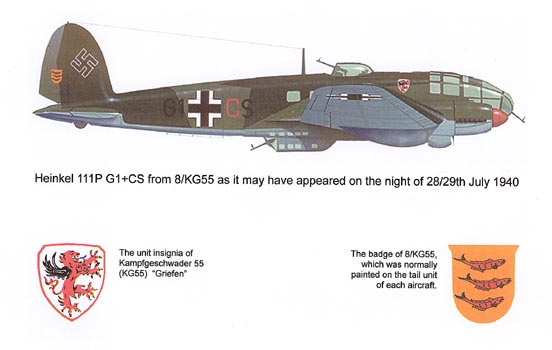
During the latter part of June 1940, following Germany's successful invasion of France and the low countries, one of the Luftwaffe's (German Air Force) front line bomber units, III/Gruppen KG55 (3rd Group Bomber Wing 55), took up residence at Villacoublay airfield near Paris. The group had over 100 Heinkel 111 bombers on strength at that time and soon started sending its aircraft on bombing missions over Britain.
On the night of 28th/29th July Heinkel 111P G1+CS, from the 8th Staffel (squadron) of III/KG55, took-off from Villacoublay and was sortied to attack Bristol. On its return journey to France the aircraft crashed near the Hampshire/Berkshire border just a couple of miles south-west of Newbury. Maps found by British intelligence in the plane seemed to indicate that its target was the dockyard at Avonmouth, whilst other records suggest that it may have been heading for the Bristol Aircraft factory at Filton. However, before the aircraft reached either of these locations it was caught by searchlights and hit by anti-aircraft fire, which damaged its port engine. The plane's bomb load was released somewhere in the Bristol area and the pilot turned for home. A little later the starboard engine started to fail and the pilot ordered his crew to bale out. Following their successful evacuation of the stricken plane it crashed at 2:00am on Monday 29th July in Fullers Lane, East Woodhay. The Heinkel was carrying a crew of five. Pilot - Theo Metzner, Observer - Josef Markl, Radio Operator - Kurt Boker, Engineer - Ernst Ostheimer and Gunner - Heinz Morgenthal. All five airmen landed safely in woodland north and east of the Hampshire village of Highclere.
The Heinkel crashed close to cottages occupied by Mr and Mrs Roland Drage and Mr and Mrs Frank Bray and their daughter Alice. Fortunately no members of either family were injured although Mrs Bray was traumatised and taken to a neighbours house where she later recovered. The Drage's owned a little white terrier which bolted from the house and was missing for over a day before being found in woodland nearby. Both Roland Drage and Frank Bray were very keen gardeners and Mr Bray annually exhibited his produce at the local horticultural show. Prior to the crash their gardens had been full of fruit and vegetables much of which was either destroyed or scorched by the burning plane. Mr Drage had several fruit trees and rows of potatoes ruined whilst Mr Bray lost runner beans and cabbages. In a corner of the garden the families had constructed a dugout or air raid shelter. Fortunately it was unoccupied at the time of the crash, as the Heinkel completely destroyed it!
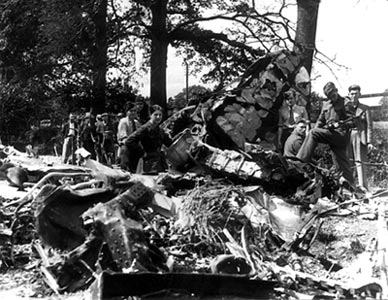
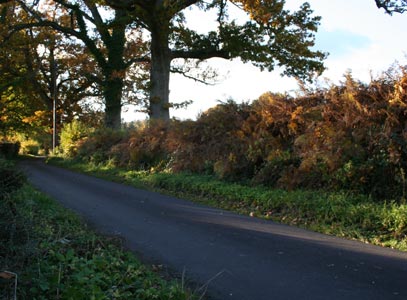
Above left: Tuesday 30th July 1940 and a large group of people have gathered to see the remains of Heinkel G1+CS, which has completely blocked Fullers Lane, East Woodhay. Is it possible that one of those present took the surviving wing flap? The man on the extreme right is Roland Drage, in whose garden the plane has crashed, and in the centre of the picture, partly hidden by the RAF personnel, is PC Hurst from Woolton Hill (Picture courtesy East Woodhay Parish Council). Above right: The same location pictured in October 2007.
Before the crash local people had been woken by the sound of the German bomber's misfiring engine. The plane was reported to have circled the area several times getting lower and lower, then there was a screaming noise followed by two explosions and a blinding flash. Mr Drage and his wife, who by this time were partly dressed, ran downstairs and out into their garden where they were confronted by the burning plane. Next door Mr Bray slept through all of the excitement until he was woken by his daughter who said that an aeroplane had crashed outside her window. He jumped out of bed, went downstairs and found part of the plane in his garden and the rest blocking the lane. Mr Bray, who was an Air Raid Warden, thought it must have been carrying incendiary bombs because the whole site was lit as if it were daylight and the heat was so intense that he was forced to hide behind the house for shelter. Trees in the adjoining meadow had caught fire and ammunition was continually exploding. Part of a wing passed over Frank Bray's head and was later found some 40 yards from the crash site.
Henry Harris, who was about 14 years old and lived with his parents at Heath End, arrived at the scene shortly after 7:00am. He was a messenger in East Woodhay Home Guard and worked for the platoons commander, Major Elliot, who owned a chicken farm near Ball Hill. Henry recalls, "When I arrived for work Major Elliot asked me if I knew where the bomber had crashed. I said, 'I think so', and we hopped into his car and I took him to the crash site. The plane just seemed to have belly flopped into the gardens of two cottages and the field behind. We hadn't been there very long when some RAF personnel arrived in a little truck and took charge".
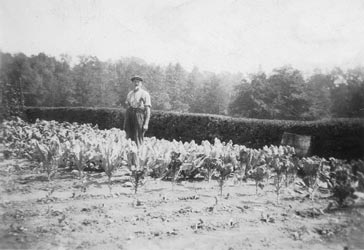
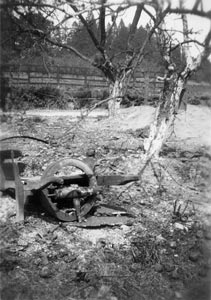
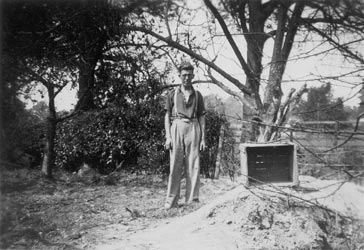
At the time of the crash the Bray and Drage families were living in a pair of semi-detached cottages in Fullers Lane, and the Heinkel crashed just a few yards to the west destroying much of the produce in their gardens. These pictures were taken shortly after the wreckage had been removed. Above left: Mr Frank Bray surveys his devastate vegetable plot. Above centre: The remains of a wheelbarrow and two very badly burnt fruit trees. Above right: The families had constructed a dugout or air raid shelter at the bottom of their garden as a place of refuge during bombing raids. Fortunately the shelter was not in use at the time of the crash, as the Heinkel landed directly on top of it! Mr Roland Drage stands beside the dugout. (All three pictures curtsey Bob Miles)
Another person who remembers the night of 29th July 1940 is Mrs Betty Dowdeswell. In 1940 she was living in Lambourn and expecting her first child. However, because her husband was away in the army, serving with the Royal Artillery on the south coast, she decided the day before the crash to go and stay with her sister-in-law Dorothy Marsh. Dorothy lived next-door to the Wheatsheaf public house (now called the Rampant Cat) in Woolton Hill. That night Betty was suddenly woken by an awful noise and saw a plane go past her bedroom window. It was a warm summer evening and her window was open with the curtains drawn back. Both girls quickly got dressed and went into the garden where they could see a glow from the burning plane and could hear ammunition exploding. They stayed in the garden for sometime before eventually going back to bed. Mrs Dowdeswell had been shocked and frightened by the night's events and a letter she penned to her husband later that day was written with a very shaky hand. Shortly afterwards she went into labour and later that evening she gave birth to her son Michael - for very obvious reasons Betty has never forgotten the day the German bomber crashed!
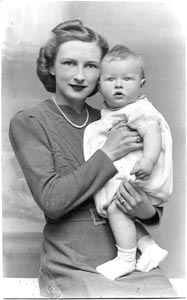
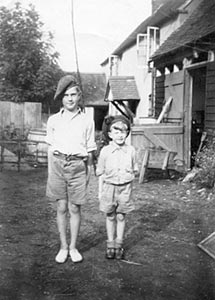
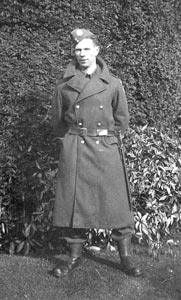
Above left: Mrs Betty Dowdeswell and son Michael pictured in May 1941. Above centre: Michael Dowdeswell (right) and his cousin Ian Marsh pretending to be soldiers. They are standing in the yard of the house in Woolton Hill where Michael's mother was staying at the time of the Heinkel crash. The Wheatsheaf pub (now the Rampant Cat) is on the right out of shot. (Both pictures Mick Dowdeswell) Above right: Montague Willis was a Private in the East Woodhay Home Guard and was called out on the night of the crash to search for the missing German airmen. (Tim Green)
Below
left: Parts of the Heinkel were salvaged from the crash site and made
into a money box, which was presented to Mrs Dowdeswell as a keep sake
Below right: A Brass plate was riveted to the top and inscribed:
Remains of Heinkel, crashed 1am, Woolton Hill, 29/7/40.
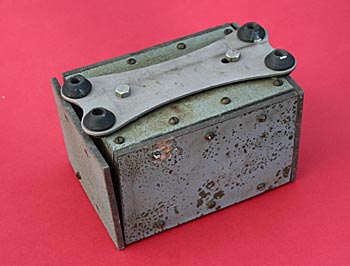
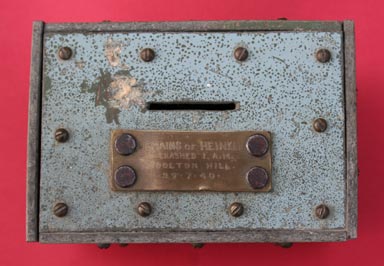
At this early stage of the war very few German aircraft had been brought down on British soil and local people were keen to visit the crash site and view the Heinkel's remains. Bill Barber from East Woodhay was 16 years old at the time and remembers visiting the crash site. "A large crowd had turned up and I only had a brief look before being ushered on by the Police who were trying to prevent people taking parts of the wrecked aircraft as souvenirs. Later camouflage nets were placed over the wreckage to hide it from view. The following night the East Woodhay Home Guard was ordered to protect the remains of the plane to stop souvenir hunters stripping it of potentially important items. Knowing that some of the bomber's crew were still at large in the area the platoon was a little nervous and easily spooked. During the night they thought they saw a bright light up in a tree and fired a shot, only to discover it was a star! This incident was the butt of many jokes for years afterwards". Schoolboy Sid Jackman and some of his mates from West Woodhay also visited the site, he recalls, "A 14 year old girl took a machine gun from the wreckage and dragged it across fields to her home at East End. The police got to hear about her 'find' and arrived later to confiscate the item".
At the time of the incident Frank Baker was a ten-year-old schoolboy living at Broardlayings, Woolton Hill. Shortly before the Heinkel crashed Frank's father had seen it circling in the night sky and thought it had an engine on fire. His wife ran upstairs shouting 'the Germans are coming', waking Frank and his brother. The following morning the two boys went to the crash site and on the way saw a Mr Richard Head and his brother struggling to pull what looked like the tail fin from the German plane through their garden gate - there was a swastika painted on the item. The boys carried on down to the crashed bomber, which was still smouldering and Frank recalls, "It wasn't long before the police and army arrived. I remember seeing baked apples hanging from a tree in the garden. There were some big pieces of wreckage lying around that were later taken away. The site was cleared pretty well, which is why we had to get there quickly in order to retrieve some bits and pieces. One of the German airmen gave himself up to Mr Neal, proprietor of the garage at Ball Hill, and Bert Admans, who lived next door to the Derby Arms public house (since renamed the Woodpecker) picked up another of the crewmen. I was told that milk left on doorsteps of houses in Penwood disappeared during the period the Germans were on the run". A few days after the crash Frank was picking apples from a tree in his parent's garden and found a Luftwaffe arm compass hanging from one of its branches (all German aircrew were issued with a compass for escape and evasion purposes - author). The compass remained in his possession until February 2008 when he kindly donated the item to the Kennet Valley at War trust's Museum at Littlecote, where it will eventually go on permanent display.

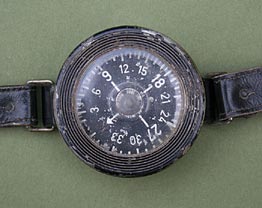
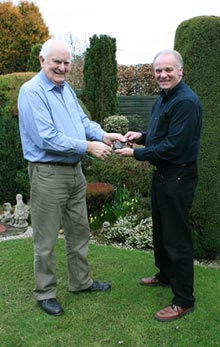
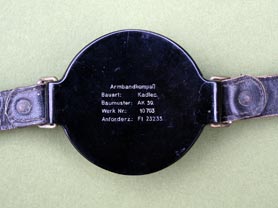
Above
top: The German arm compass found by Frank Baker a few days after
the crash, hanging from an apple tree in his parent's garden.
Above left and right: Close up details of front and back. Above
centre: Frank Baker (left) handing the compass to Roger Day from the
Kennet Valley at War Trust.
As no bodies were found in the wreckage it was obvious the crew had escaped from the bomber by parachute. Local Home Guard units were called out to look for the missing airmen and Montague Willis, who lived at Barncroft Cottage and was a member of the East Woodhay Platoon, joined the search. His daughter, Sylvia, recalls that her father was out all night and that because 'desperate' Germans were on the loose she and her brother Derek were locked indoors! About half an hour after the crash Albert Admans, who in civilian life was a taxi driver, reported for Home Guard duty. When he arrived at his post, which was about a mile-and-a-half from the crash site, he was unaware of what had happened and only learnt about the incident from the men he relieved. After he had been on duty for about three hours he was approached by a special constable. The officer told him that he had seen someone standing in a ditch about a mile along the road smoking a cigarette, but he did not think it was one of the parachutists. However, Mr Admans' suspicions were aroused and he decided to investigate. Leaving two colleagues at the post he jumped in his car and drove to the spot described by the special constable. Nearby he found a person walking beside the road and on apprehending him discovered he was one of the missing airmen. After searching the German he put him in his car and drove back to his post. He then persuaded one of his colleagues to sit in the back of the car with the prisoner while he drove to the police station, where the German revealed that he was Feldwebel Theo Metzner, the Heinkel's pilot.
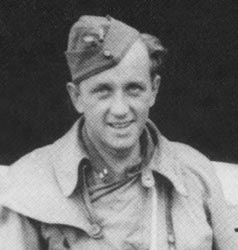
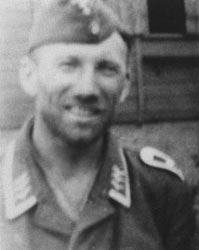
Above
left: The German pilot Theo Metzner. Above right: The
Heinkel's Observer Josef Markl
(Both pictures reproduced with the kind permission of Red Kite Publishing)
The second airman taken into captivity was radio operator Kurt Boker who had landed in a field and sprained his left leg. As soon as dawn broke Boker decided to give himself up and set off along a road looking for habitation. After awhile a police car appeared and he was taken prisoner and driven to a police house. There the policeman's wife offered him tea and biscuits, which he thankfully accepted. Despite these successes there were still three German airmen on the loose and the military authorities, who were under increasing pressure to capture them, were now searching areas of woodland on the Highclere estate. During the summer of 1940 Bert Parfitt and his father were working for Chivers of Devizes helping to build Barton Stacey Camp near Winchester. Despite living in East Woodhay neither of them had heard anything of the night's events. That morning, whilst making their way to Burghclere to catch the works bus, they were surprised to find a parachute caught in telephone wires beside the Andover road. At this point in time they still had no knowledge of the plane crash or the missing airmen. Later that afternoon (about 5:30pm), whilst returning home from Barton Stacey, they were approaching the Carnarvon Arms public house on the A34 and noticed soldiers lined up beside the road preparing to go into nearby woodland. They were told that the soldiers were searching for missing airmen and this was the first they knew about the events of earlier that day. When they reached the Andover road the parachute they had spotted during the morning had been removed.
A couple of days after the crash a number of Canadian troops arrived by lorry to help with the search. A group of local lads, which included 11 year old Tony Gale from Penwood, had been watching the soldier's activities throughout most of the day, but it was not until the Canadians were getting ready to return to camp that the excitement began, as Tony recalls, "The soldiers spent all day in the woods and finished their search at White Oak where lorries were waiting to take them back to camp. Before boarding one of the lorries a soldier wondered off to relive himself against a Rhododendron bush, and inadvertently urinated on two German airmen hiding there, who immediately gave themselves up. They both looked very young and were dressed in light grey/blue Luftwaffe uniforms, which had yellow collar patches with tiny silver wings. Mr Baker, a local man who could speak German, interrogated them and shortly afterwards the Canadians marched them back into the woods. A little while later they retuned with a revolver, which I think the airmen had been using to shoot rabbits". The two captured Germans were Ernst Ostheimer and Heinz Morgenthal - this left just one enemy airman at large, the Heinkel's observer Josef Markl.
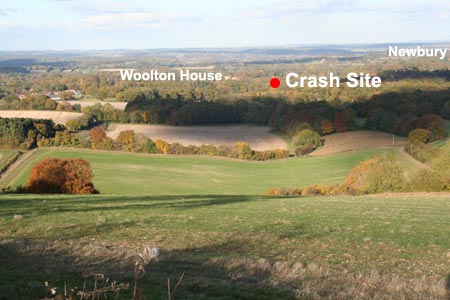
Above: The view looking north-east from Pilot Hill. Josef Markel, the German bomber's observer, remained at large in the woods in this area for nine days before eventually giving himself up to the authorities.
When Markl jumped from the stricken Heinkel bomber he experienced a number of problems. Firstly he caught his foot, which had to be freed by one of his fellow crew members. While this was going on his parachute was blown away from his body and as he fell he had difficulty clutching on to it and finding its ripcord. As soon as the parachute had opened he stated oscillating and eventually ended his decent caught by the telephone wires of his flying helmet in a pine tree. He had landed somewhere in the grounds of Highclere Park and after untangling himself destroyed everything on his person that he considered of military value. Then, after climbing down from the tree, he hid his flying helmet and set off for Newbury to give himself up. On reaching the town Markl decided that he would rather be taken than surrender and wandered back to the outskirts of Newbury where he hid in some scrub. Apart from a bar of chocolate he had lost all of his survival rations and was eating edible roots from nearby fields and drinking water from a stream.
Amazingly, Markl saw no one for the first five or six days. Eventually two farmers who were examining a hay field passed within 30 yards of his hiding place, but he stayed perfectly still and was unseen. Later he spotted a man with a dog who was out pigeon shooting. He quickly climbed a tree and shortly afterwards the man walked directly beneath the branch he was sitting on, but once again he remained undetected. By this time Markl's lack of nourishment was taking its toll, and, as he got weaker and weaker, so capture began to look an attractive option. On Monday 5th August Markl wandered off and found an unlocked shed at a clay-pigeon shooting butt, where he spent the night. The following day he decided it was time to give himself up and made his way to the Andover road. There he encountered several people none of whom seemed remotely interested in his presence. It was around this time that the following incident, recounted by Tony Gale, must have occurred. "The last German captured initially tried to give himself up near White Oak to a Miss Jessie Ballard. However, as soon as she saw him Jessie ran off and did not stop until she reached Highclere Post Office where she knew there was a telephone". Whether Jessie ever notified the authorities of her sighting has been not been recorded.
A short while later another car passed Markl. The vehicle was chauffeur driven and stopped a little way along the road before reversing towards him. Sitting in the back of the car was Lady Buckland who lived at Woolton House and owned the field and cottages where the German bomber crashed. Markl, who spoke quite good English, explained to the chauffeur, Mr E. Nicholls, that he wanted to be taken to the nearest military commander. He seemed somewhat surprised that Lady Buckland was not frightened by his presence, until told that four other airmen had been captured in the neighbourhood some days previously. He got into the car and sat next to Mr Nicholls and was driven the three or four miles to Newbury Police Station. During the course of the journey Lady Buckland struck up a conversation with Markl. He told her that German airmen were made to believe that if they gave themselves up in England they would be treated very badly. He then asked her if she thought the English would give up, to which she reportedly replied, "No never, why should we?" When Markl got out of the car in Newbury he bowed and thanked Lady Buckland. She immediately asked the arresting police superintendent to give him a good meal.
Once inside
the police station Markl surrendered his revolver, plus sixteen rounds of
ammunition, and seemed very willing to answer all questions put to him. He
had been 'on the run' for nine days, a remarkable achievement considering
the number of people out looking for him, and the longest single period any
Luftwaffe airman evaded capture in England during World War Two!
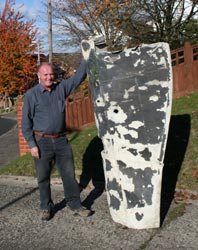
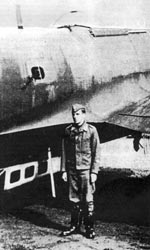
Above
left: Part of the starboard wing flap
from a Heinkel 111 bomber found in outbuildings at "Ravensfield",
Ramsbury in 1997. Following extensive research the author's in little doubt
that this flap once belonged to Heinkel G1+CS, which crashed in Fullers Lane
East Woodhay during the early hours of Monday 29th July 1940. Above
right: Radio operator Kurt Boker poses beside Heinkel G1+CS on 28th
July, just hours before the plane's last mission. The starboard wing flap
is clearly visible slightly above and to the right of Boker's left shoulder
(via Adrian Crossan).
©
Copyright 2007 Roger Day